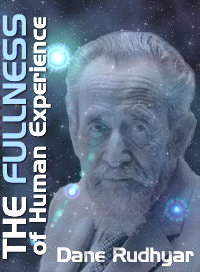 |
| Home | Bio | Art | Music | Literature | Civilization & Culture | Philosophy of Wholeness | Theosophy & Spirituality | Astrology |

CHAPTER NINE
The "Dangerous Forties" in the Life-Cycle of Humanity - 2 Crises of social and personal transformation When a teenage boy or girl leaves a strictly religious family molded by traditions of the American South and suddenly finds himself or herself living in a very progressive university, the change can be shocking. The mind that fed mostly on Biblical imagery and beliefs suddenly has to assimilate materialistic and perhaps "far to the left" ideas. The shock can be even greater if, having shown unusual intelligence, a teenage youth from a traditional peasant European family has been sent by a wealthy American to study in the United States. Another kind of radical change may be experienced if a small-town lovely girl working at a menial job, is courted by a rich man and marries him. Her latent mental faculties may rapidly develop as she faces an entirely different kind of interpersonal relationship. In the life of most human beings a change involving both biological and psychological readjustment can be expected after what used to be called the mid-life period. This is the "change of life," also spoken of as the crisis of the forties, or the dangerous forties. In many instances, such a crisis precedes the biological menopause in women, and it is often experienced, in some perhaps less-overt manner, by men as well as women. An ego-type of subjective consciousness and desire which had become deeply involved in biological experiences (sex, child-bearing, nurturing, etc.) may more or less suddenly feel or imagine that the years of biological youth are nearly gone and that a deep-seated readjustment is imperative, whatever one's conditions of life (single or married, with or without children, etc.) have been for many years. The development of a somewhat new type of ego may be the answer to the new situation. In other cases, an attempt may be made to transcend altogether the ego level as it manifests in our present society, and to align one's consciousness with that of pioneers in the development of a new kind of interpersonal relationship and/or societal organization. In ancient cultures in which the life-span of a human being was divided into quite sharply differentiated periods, each with a definite meaning and function, the "change of life" after age forty often led to a basic alteration in a person's activities and feeling-responses. From a more modern psychological point of view, the change may not have such definite outer social or family implications and expected consequences, but it should be understood as a process of personal and psychic readjustment which to some extent polarizes what was experienced at the time of puberty; thus I have spoken of it as "adolescence in reverse." If the years surrounding puberty had involved a strong psychological or psychic crisis, this crisis may have a more or less related counterpart during the seven-year period from age forty-two to forty-nine. These years may witness either a tense, quite irrational and perhaps antisocial (or asocial) reaction against the set patterns of family and/or business which had dominated the twenties and thirties, or a kind of resigned acceptance of the life process. In the most positive cases, however, the crisis may be made to serve a conscious and deliberate process of transformation. The subjective desires and mental images of achievement of the individual person may be reoriented and made to resonate, however feebly, to the tidal rhythm of the Movement of Wholeness. This crisis of the forties in a person's life may be significantly used to interpret in a broad and symbolic sense a corresponding period of tense and crucial readjustments in the long-term evolution of mankind. We are today passing through such a period. By realizing what is implied in such a correspondence, we may understand in depth, and no longer merely in terms of superficial symptoms (wars and revolutions), what has really taken place in the Western world, particularly during the last centuries. Humanity is experiencing a potentially drastic "change of life." It is experiencing it because the Movement of Wholeness on this planet has reached a new phase in the relationship of the two great principles which structure the evolution of humanity. The correspondence is evidently not obvious if we assume the validity of the today generally accepted Darwinian theory, and we think of biological and human evolution exclusively in material and biological terms. However, if we do, we cannot answer the crucial question: Why has the radical change in the state of human society, of human thinking, and lately of the balance of forces in the whole biosphere, been so sudden and spectacular after an immense period of relatively slow transformation over millions of years? Two answers may be given to this question. The first involves the entire planet as it moves around the center of our galaxy: the earth may have moved into a region where strikingly new energies or subtle substances are active. The second answer implies that our present humanity is only one in a series of successive developments, each of which brings out a specific range of the vast possibilities contained in the archetype MAN. Humanity was born and has been growing through definite age periods which roughly correspond to childhood, adolescence, and training for mature biological and social activity, then productive maturity. Now a crisis of transition, the "change of life" is being experienced. It may (yet need not) lead to one or two new age-periods. If, however, we relate the sequence of age-periods in the unfoldment of an individual person to that of the vast cycles of evolution of mankind as a whole, we have to deal not merely with the birth, development, and gradual disintegration of particular races and cultures, but with altogether different types of human civilizations on more or less definable continents. We are dealing with what the most well-known quasi-esoteric traditions of our time have named Lemuria and Atlantis, and with the present spread of continental masses. Each of these stages of continental formation and the type of human beings having operated and now operating on them corresponds to one basic age period. Humanity, as homo sapiens, was "born" on Lemuria and there experienced its childhood; its years of adolescence correspond to the Atlantean period. With the gradual disintegration of the Atlantean regions (which may have ended around 8000 B.C., but had already started several hundred thousand years before), our present humanity began. Its geographical "heart center" is traditionally located in central Asia (the mysterious and invisible Shambhala), but its entire field of operation encompasses Eurasiafrica and, presumably, its geomorphic polarity, the Americas. The present phase of human evolution therefore corresponds, in a global sense, to the period of maturity in a person's life-span (in general, between age twenty-eight and forty-two). The crisis of the forties, which presumably began several millennia ago, when large cities were built and a new type of psychological responses and ego-ambitions developed, has reached a virulent state — particularly since the Renaissance, the growth of the scientific mentality, and the desires and expectations associated with the ideal of democracy and egalitarianism in all fields. Where the crisis will lead is evidently the most basic question one would want to be able to answer. Any answer, however, will be conditioned by the basic meaning one gives to the crisis; thus by the level at which one thinks and operates. If the change is thought to refer primarily or essentially to the level of material productivity and socio-cultural and political developments, a tentative scenario for the future may be outlined. It may sound logical, but only if no spectacular cataclysm or all-out nuclear war occurs. One may also believe that the outer transformation of mankind implies, is caused by, or at least is synchronous with a fundamental change involving the way a person "feels-thinks" about himself or herself — a person's self-image in relation to his or her place in the universe, or to God. Then one is confronted with a very different set of possibilities. Beyond the external social and material changes, one may perceive the rhythmic unfoldment of a process of all-human planetary transformation, one phase of which is gradually closing and another opening. Rapid as it may be in terms of geological time, the transition may nevertheless take several millennia of historical time to be completed. Whether it is successfully completed in the foreseeable future should not be considered certain. The Greek (or Greco-Roman) culture was assuredly not a complete success. Yet it produced lasting results. It fecundated the minds of the pioneers of the Renaissance who reacted against the overwhelming power of the Medieval Catholic Order which had tried in vain to reproduce, at a new religious level, the material successes of the Roman Empire. European "humanism" led to the spontaneous but violent individualism of the Renaissance, and the struggle between gradually solidified nation-states, recalling on a larger scale the wars between Mediterranean city-states. Yes, "success" is evident if evaluated in terms of technological achievements. Similarly, the forty-year-old businessman or professional may find himself or herself in a solid social position; but his teenage children may have been arrested for the possession of drugs and require psychiatric care, while his marriage may be collapsing in meaninglessness. Our present international world may be considered successful in what it has attempted to achieve at the level of consciousness and material welfare. But racked as it is today by psychic as well as economic conflicts, it probably has not yet reached the climactic point at which it will have fully to meet the karma of disharmonic collective efforts which produced the Industrial and Electronic Revolutions with their rapid spread over the whole globe. Whether this karma is successfully met may depend on a more realistic and complete understanding not only of the meaning of this "crisis of the forties," but of the state of being which may be at least partially reached by humanity if its planetary dharma is fulfilled, and if it moves to a new level of consciousness and activity. Our problem is indeed to realize what is possible, however lengthy the process of actualization. We need an ideal to orient our efforts. Such an orientation may be obtained in an unexpected way if we study and really understand what the ancient system of organization in India, the Laws of Manu, established as basic periods of development in a human life. The fundamental meanings of these periods have often been misunderstood, especially insofar as the two last ones are concerned. Throwing a somewhat new light upon them should illumine our present human problems even if what is suggested may hardly seem possible in present world conditions. Conditions, however, must change. By permission of Leyla Rudhyar Hill Copyright © 1986 by Leyla Rudhyar Hill All Rights Reserved.  Web design and all data, text and graphics appearing on this site are protected by US and International Copyright and are not to be reproduced, distributed, circulated, offered for sale, or given away, in any form, by any means, electronic or conventional. See Notices for full copyright statement and conditions of use. Web design copyright © 2000-2004 by Michael R. Meyer. All Rights Reserved. |
 |
